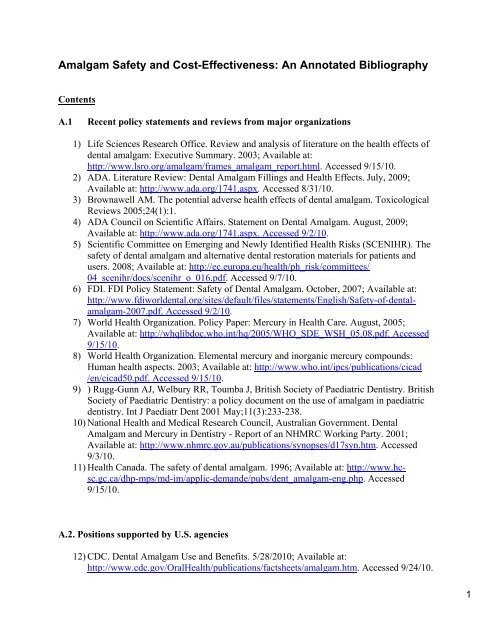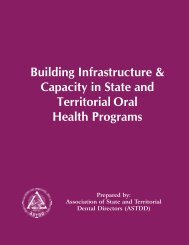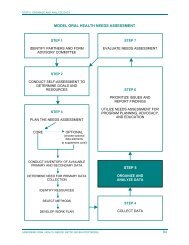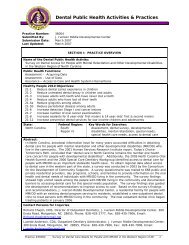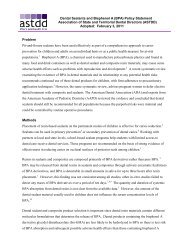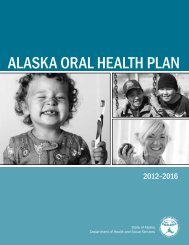Amalgam Safety and Cost-Effectiveness: An Annotated Bibliography
Amalgam Safety and Cost-Effectiveness: An Annotated Bibliography
Amalgam Safety and Cost-Effectiveness: An Annotated Bibliography
Create successful ePaper yourself
Turn your PDF publications into a flip-book with our unique Google optimized e-Paper software.
<strong>Amalgam</strong> <strong>Safety</strong> <strong>and</strong> <strong>Cost</strong>-<strong>Effectiveness</strong>: <strong>An</strong> <strong>An</strong>notated <strong>Bibliography</strong><br />
Contents<br />
A.1 Recent policy statements <strong>and</strong> reviews from major organizations<br />
1) Life Sciences Research Office. Review <strong>and</strong> analysis of literature on the health effects of<br />
dental amalgam: Executive Summary. 2003; Available at:<br />
http://www.lsro.org/amalgam/frames_amalgam_report.html. Accessed 9/15/10.<br />
2) ADA. Literature Review: Dental <strong>Amalgam</strong> Fillings <strong>and</strong> Health Effects. July, 2009;<br />
Available at: http://www.ada.org/1741.aspx. Accessed 8/31/10.<br />
3) Brownawell AM. The potential adverse health effects of dental amalgam. Toxicological<br />
Reviews 2005;24(1):1.<br />
4) ADA Council on Scientific Affairs. Statement on Dental <strong>Amalgam</strong>. August, 2009;<br />
Available at: http://www.ada.org/1741.aspx. Accessed 9/2/10.<br />
5) Scientific Committee on Emerging <strong>and</strong> Newly Identified Health Risks (SCENIHR). The<br />
safety of dental amalgam <strong>and</strong> alternative dental restoration materials for patients <strong>and</strong><br />
users. 2008; Available at: http://ec.europa.eu/health/ph_risk/committees/<br />
04_scenihr/docs/scenihr_o_016.pdf. Accessed 9/7/10.<br />
6) FDI. FDI Policy Statement: <strong>Safety</strong> of Dental <strong>Amalgam</strong>. October, 2007; Available at:<br />
http://www.fdiworldental.org/sites/default/files/statements/English/<strong>Safety</strong>-of-dentalamalgam-2007.pdf.<br />
Accessed 9/2/10.<br />
7) World Health Organization. Policy Paper: Mercury in Health Care. August, 2005;<br />
Available at: http://whqlibdoc.who.int/hq/2005/WHO_SDE_WSH_05.08.pdf. Accessed<br />
9/15/10.<br />
8) World Health Organization. Elemental mercury <strong>and</strong> inorganic mercury compounds:<br />
Human health aspects. 2003; Available at: http://www.who.int/ipcs/publications/cicad<br />
/en/cicad50.pdf. Accessed 9/15/10.<br />
9) ) Rugg-Gunn AJ, Welbury RR, Toumba J, British Society of Paediatric Dentistry. British<br />
Society of Paediatric Dentistry: a policy document on the use of amalgam in paediatric<br />
dentistry. Int J Paediatr Dent 2001 May;11(3):233-238.<br />
10) National Health <strong>and</strong> Medical Research Council, Australian Government. Dental<br />
<strong>Amalgam</strong> <strong>and</strong> Mercury in Dentistry - Report of an NHMRC Working Party. 2001;<br />
Available at: http://www.nhmrc.gov.au/publications/synopses/d17syn.htm. Accessed<br />
9/3/10.<br />
11) Health Canada. The safety of dental amalgam. 1996; Available at: http://www.hcsc.gc.ca/dhp-mps/md-im/applic-dem<strong>and</strong>e/pubs/dent_amalgam-eng.php.<br />
Accessed<br />
9/15/10.<br />
A.2. Positions supported by U.S. agencies<br />
12) CDC. Dental <strong>Amalgam</strong> Use <strong>and</strong> Benefits. 5/28/2010; Available at:<br />
http://www.cdc.gov/OralHealth/publications/factsheets/amalgam.htm. Accessed 9/24/10.<br />
1
13) National Institutes of Health<br />
http://www.nidcr.nih.gov/Research/ResearchResults/NewsReleases/ArchivedNewsReleas<br />
es/NRY2006/PR04182006.htm. Accessed 9/24/10.<br />
B. Recent clinical trials<br />
14) DeRouen TA, et al. Neurobehavioral effects of dental amalgam in children: a<br />
r<strong>and</strong>omized clinical trial. JAMA 2006;295(15):1784.<br />
15) Lauterbach M, Martins IP, Castro-Caldas A, et al. Neurological outcomes in children<br />
with <strong>and</strong> without amalgam-related mercury exposure: Seven years of longitudinal<br />
observations in a r<strong>and</strong>omized trial. J Am Dent Assoc 2008;139(2):138.<br />
16) Bellinger DC, Trachtenberg F, Barregard L, et al. Neuropsychological <strong>and</strong> renal effects<br />
of dental amalgam in children: a r<strong>and</strong>omized clinical trial. JAMA 2006;295(15):1775-<br />
1783.<br />
17) Kingman A, Albers JW, Arezzo JC, et al. <strong>Amalgam</strong> exposure <strong>and</strong> neurological function.<br />
NeuroToxicology 2005;26(2):241-255.<br />
C. Survival studies of amalgam <strong>and</strong> alternative materials<br />
18) Bernardo M, Luis H, Martin MD, Leroux BG, Rue T, Leitao J, et al. Survival <strong>and</strong> reasons<br />
for failure of amalgam versus composite posterior restorations placed in a r<strong>and</strong>omized<br />
clinical trial. J Am Dent Assoc 2007 Jun;138(6):775-783.<br />
19) Beazoglou T, Eklund S, Heffley D, Meiers J, Brown LJ, Bailit H. Economic impact of<br />
regulating the use of amalgam restorations. Public Health Rep 2007;122(5):657-663.<br />
20) Opdam NJM, Bronkhorst EM, Loomans BAC, Huysmans MC. 12-Year survival of<br />
composite vs. amalgam restorations. J Dent Res 2010;89(10):1063-1067.<br />
21) Simecek JW, Diefenderfer KE, Cohen ME. <strong>An</strong> evaluation of replacement rates for<br />
posterior resin-based composite <strong>and</strong> amalgam restorations in US Navy <strong>and</strong> Marine Corps<br />
recruits. J Am Dent Assoc 2009;140(2):200-209.<br />
22) Soncini JA, Maserejian NN, Trachtenberg F, Tavares M, Hayes C. The longevity of<br />
amalgam versus compomer/composite restorations in posterior primary <strong>and</strong> permanent<br />
teeth: Findings From the New Engl<strong>and</strong> Children's <strong>Amalgam</strong> Trial. J Am Dent Assoc<br />
2007;138(6):763-772.<br />
23) Van Nieuwenhuysen JP, D'Hoore W, Carvalho J, Qvist J. Long-term evaluation of<br />
extensive restorations in permanent teeth. J Dent 2003;31(6):395-405.<br />
D. U.S. Food <strong>and</strong> Drug Administration (FDA) <strong>and</strong> dental amalgam<br />
24) About Dental <strong>Amalgam</strong> Fillings. Available at:<br />
http://www.fda.gov/MedicalDevices/Products<strong>and</strong>MedicalProcedures/DentalProducts/Den<br />
tal<strong>Amalgam</strong>/ucm171094.htm. Accessed: 9/22/10.<br />
25) FDA. Class II Special Controls Guidance Document: Dental <strong>Amalgam</strong>, Mercury, <strong>and</strong><br />
<strong>Amalgam</strong> Alloy. July 28, 2009; Available at:<br />
http://www.fda.gov/MedicalDevices/DeviceRegulation<strong>and</strong>Guidance/GuidanceDocument<br />
s/ucm073311.htm.<br />
2
26) FDA. FDA Issues Final Regulation on Dental <strong>Amalgam</strong>. July 28, 2009; Available at:<br />
http://www.fda.gov/NewsEvents/Newsroom/Pressannouncements/ucm173992.htm.<br />
Accessed 9/22/10.<br />
27) Plans to review regulation of dental amalgam. June 10, 2010; Available at:<br />
http://www.fda.gov/NewsEvents/Newsroom/Press<strong>An</strong>nouncements/ucm215061.htm.<br />
Accessed 7/26/10.<br />
28) Dental Products Panel of the Medical Devices Advisory Committee; Notice of Meeting.<br />
75 Federal Register 33315 (2010-06-11).<br />
29) National Research Council (U.S.) Committee on Improving Risk <strong>An</strong>alysis Approaches<br />
Used by the U.S. EPA, Board on Environmental Studies <strong>and</strong> Toxicology, Division of<br />
Earth <strong>and</strong> Life Sciences. Science <strong>and</strong> Decisions: Advancing Risk Assessment.<br />
Washington, DC: National Academies Press; 2009.<br />
E. U.S. Environmental Protection Agency (EPA) <strong>and</strong> dental amalgam<br />
30) EPA. EPA will propose rule to protect waterways by reducing mercury from dental<br />
offices - Existing technology is available to capture dental mercury. September 27, 2010;<br />
Available at: http://yosemite.epa.gov/opa/admpress.nsf/e77fdd4f5afd88a385257<br />
6b3005a604f /a640db2ebad201cd852577ab00634848!OpenDocument. Accessed<br />
9/30/2010.<br />
31) ADA, NACWA, & EPA. Memor<strong>and</strong>um of Underst<strong>and</strong>ing on Reducing Dental <strong>Amalgam</strong><br />
Discharges. December 23, 2008; Available at:<br />
http://water.epa.gov/scitech/wastetech/guide/dental/upload/2008_12_31_guide_dental_m<br />
ou.pdf. Accessed 9/30/2010.<br />
3
A.1 Recent policy statements <strong>and</strong> reviews from major organizations:<br />
(1) Life Sciences Research Office. Review <strong>and</strong> analysis of literature on the health effects<br />
of dental amalgam: Executive Summary. 2003; Available at:<br />
http://www.lsro.org/amalgam/frames_amalgam_report.html. Accessed 9/15/10.<br />
(2) ADA. Literature Review: Dental <strong>Amalgam</strong> Fillings <strong>and</strong> Health Effects. July, 2009;<br />
Available at: http://www.ada.org/1741.aspx. Accessed 8/31/10.<br />
(3) Brownawell AM. The potential adverse health effects of dental amalgam.<br />
Toxicological Reviews 2005;24(1):1.<br />
LSRO conducted an independent review of recent scientific literature at the request of several<br />
U.S. agencies, including the NIDCR <strong>and</strong> CDC. The findings of this report were summarized in<br />
an Executive Report (1) <strong>and</strong> in a peer-reviewed article (3). The article is a concise, yet thorough,<br />
review of dental amalgam, its role as a source of elemental mercury exposure, <strong>and</strong> the known<br />
effects of this exposure. It also includes a review of human exposure to methylmercury, which<br />
occurs primarily through the consumption of fish <strong>and</strong> other contaminated seafood, <strong>and</strong> how this<br />
interrelates with exposure from dental sources. The authors discuss the nonspecific psychological<br />
<strong>and</strong> physiological effects that are sometimes attributed to dental amalgam (e.g., fatigue,<br />
depression, loss of mental acuity, etc) are not the same as adverse reactions known to occur in<br />
cases of occupational exposure. These specific, “well defined set of effects” include tremor,<br />
stomatitis, hearing loss, <strong>and</strong> renal impairment (3).<br />
The LSRO report, along with an updated literature review by the ADA in 2009 (2), represent<br />
current, thorough reviews of the recent scientific evidence regarding dental amalgam safety. The<br />
LSRO report examined peer-reviewed publications from 1996 through 2003, <strong>and</strong> the ADA<br />
update reviewed publications from 2004 through May, 2008. The ADA’s objective was to<br />
identify new studies that addressed research gaps identified in the LSRO’s report to determine<br />
whether new information could be added to the body of knowledge regarding amalgam safety<br />
The LSRO report concluded that recent, peer-reviewed studies “did not reveal sufficient<br />
evidence to support a causal relationship between dental amalgam restorations <strong>and</strong> human health<br />
problems” besides rare instances of allergic reaction (3). The ADA review found that several<br />
studies published between 2004 <strong>and</strong> 2008 – notably related to the New Engl<strong>and</strong> Children’s<br />
<strong>Amalgam</strong> Trial <strong>and</strong> the Casa Pia study – demonstrated “no consistent evidence of harm”,<br />
including from use of dental amalgam in young children (2).<br />
These reports present a detailed outline of currently available evidence, as well as major gaps in<br />
research knowledge. LSRO calls for studies of low-level exposure to mercury vapor, better<br />
designed studies of exposure to mercury vapor <strong>and</strong> its effects among dental professionals.<br />
Allergic sensitivities to mercury in dental patients are rare, but studies of potential genetic<br />
sensitivities to mercury are needed. The ADA reviewed recent research that has found no<br />
evidence of genetic susceptibility to mercury <strong>and</strong> that studies in children have no found no<br />
evidence of harm. More studies are needed to study the effects of mercury exposure in dental<br />
professionals <strong>and</strong> the secretion of mercury from breast milk.<br />
4
(4) ADA Council on Scientific Affairs. Statement on Dental <strong>Amalgam</strong>. August, 2009;<br />
Available at: http://www.ada.org/1741.aspx. Accessed 9/2/10.<br />
This statement cites several sources, most of which are included in this bibliography, to support<br />
their position that amalgam is a “valuable, viable <strong>and</strong> safe choice for dental patients” <strong>and</strong> the<br />
importance of ongoing research.<br />
(5) Scientific Committee on Emerging <strong>and</strong> Newly Identified Health Risks (SCENIHR).<br />
The safety of dental amalgam <strong>and</strong> alternative dental restoration materials for patients <strong>and</strong><br />
users. 2008; Available at: http://ec.europa.eu/health/ph_risk/committees/<br />
04_scenihr/docs/scenihr_o_016.pdf. Accessed 9/7/10.<br />
This committee examined dental amalgam <strong>and</strong> its alternatives in regards to consumer safety <strong>and</strong><br />
environmental effects. SCENIHR concludes that “there is no scientific evidence for risks of<br />
adverse systemic effects” in association with dental amalgam. <strong>Amalgam</strong> <strong>and</strong> alternative<br />
materials are rarely associated with local adverse effects such as allergies. The committee noted<br />
that the use of amalgam is declining, as aesthetics <strong>and</strong> minimally invasive techniques become<br />
more common.<br />
(6) FDI. FDI Policy Statement: <strong>Safety</strong> of Dental <strong>Amalgam</strong>. October, 2007; Available at:<br />
http://www.fdiworldental.org/sites/default/files/statements/English/<strong>Safety</strong>-of-dentalamalgam-2007.pdf.<br />
Accessed 9/2/10.<br />
This brief statement is similar to the SCENIHR conclusions; “there is no evidence to support an<br />
association between the presence of amalgam restorations <strong>and</strong> chronic degenerative diseases,<br />
kidney disease, autoimmune disease, cognitive function, adverse pregnancy outcomes or any<br />
non-specific symptoms.” The FDI statement includes citations from the NECAT <strong>and</strong> Casa Pia<br />
studies of amalgam restorations in children. Individual allergies to some component of amalgam<br />
are rare. Other restorative materials may have adverse effect, but this statement is not elaborated<br />
upon.<br />
In a news release dated December 1, 2009, the FDI announced their participation in a joint<br />
meeting with the World Health Organization (WHO) <strong>and</strong> the United Nations Environmental<br />
Programme (UNEP) in November, 2009. At that meeting, FDI officials presented their position<br />
that “no ban or phase-down of mercury used in the dental profession should occur before a true<br />
alternative to dental amalgam is widely available in all countries.” 1<br />
1 FDI. FDI Participates at WHO/UNEP Meeting on Future Use of Materials for Dental Restoration.<br />
12/1/2009; Available at: http://www.fdiworldental.org/content/fdi-participates-whounep-meeting-futureuse-materials-dental-restoration,<br />
9/30/2009.<br />
5
(7) World Health Organization. Policy Paper: Mercury in Health Care. August, 2005;<br />
Available at: http://whqlibdoc.who.int/hq/2005/WHO_SDE_WSH_05.08.pdf. Accessed<br />
9/15/10.<br />
The use of mercury in the healthcare industry represents a source of environmental<br />
contamination through wastewater <strong>and</strong> incineration. WHO advocates immediate development of<br />
better waste h<strong>and</strong>ling practices, <strong>and</strong> a long term ban on use of mercury-containing devices.<br />
Dental amalgam is cited as the major source of mercury vapor in non-industrialized settings, but<br />
is not singled out for any adverse effects other than as a source of environmental contamination.<br />
(8) World Health Organization. Elemental mercury <strong>and</strong> inorganic mercury compounds:<br />
Human health aspects. 2003; Available at: http://www.who.int/ipcs/publications/cicad<br />
/en/cicad50.pdf. Accessed 9/15/10.<br />
This lengthy report was based on the 1999 U.S. ATSDR (Agency for Toxic Substances <strong>and</strong><br />
Disease Registry) document “Toxicological profile for mercury (update)”. Dental amalgams are<br />
discussed briefly as one of many sources of population mercury exposure. Most scientific<br />
citations regarding dental amalgam are from the 1990s.<br />
(9) Rugg-Gunn AJ, Welbury RR, Toumba J, British Society of Paediatric Dentistry.<br />
British Society of Paediatric Dentistry: a policy document on the use of amalgam in<br />
paediatric dentistry. Int J Paediatr Dent 2001 May;11(3):233-238.<br />
Improved mercury hygiene practices are called for by BSPD to reduce environmental<br />
contamination <strong>and</strong> “this is likely to be the main reason for Government action against the use of<br />
amalgam in the future”. This document provides a brief summary of actions taken by other<br />
European counties in regards to dental amalgam. The BSPD supports the position that “no<br />
restrictions should be placed upon the use of silver amalgam to restore children’s teeth”.<br />
Durability of several materials (e.g., amalgam, stainless steel crowns, composites, <strong>and</strong> glass<br />
ionomers) are compared for pediatric restorations.<br />
(10) National Health <strong>and</strong> Medical Research Council, Australian Government. Dental<br />
<strong>Amalgam</strong> <strong>and</strong> Mercury in Dentistry - Report of an NHMRC Working Party. 2001;<br />
Available at: http://www.nhmrc.gov.au/publications/synopses/d17syn.htm. Accessed<br />
9/3/10.<br />
NHMRC recommended avoiding the use of amalgam in primary teeth. This recommendation<br />
was not derived from evidence, “but from a combination of uncertainty <strong>and</strong> application of<br />
general public <strong>and</strong> environmental health principles” that indicate a reduction of exposure to<br />
mercury where “safe <strong>and</strong> practical alternatives exist”. The report also suggested minimizing the<br />
use of amalgam in “susceptible population groups”, including children, pregnant women, <strong>and</strong><br />
people with kidney disease.<br />
6
However, it is worth noting that an Australian public information guide citing this report<br />
repeatedly states that there is no scientific evidence of harm from amalgam restorations, other<br />
than rare allergic reactions. 2 Information available from the Australian Dental Association<br />
website reiterates the safety of dental amalgam <strong>and</strong> opposes the replacement of amalgam<br />
restorations for any reason besides aesthetic concerns. The amalgam policy statement available<br />
from the ADA 3 discusses waste management concerns <strong>and</strong> does not contain any<br />
recommendations about the use of amalgam as a restorative material.<br />
(11) Health Canada. The safety of dental amalgam. 1996; Available at: http://www.hcsc.gc.ca/dhp-mps/md-im/applic-dem<strong>and</strong>e/pubs/dent_amalgam-eng.php.<br />
Accessed<br />
9/15/10.<br />
Health Canada’s recommendations parallel the recommendations of Australia. They also note<br />
that “current evidence does not indicate that dental amalgam is causing illness in the general<br />
population”, but do assert that a small number of people may be “hypersensitive” to mercury.<br />
The government also supports the position that a total ban of amalgam is not called for, although<br />
reduced use of heavy metals is a sound environmental precaution.<br />
2 NHMRC. Dental amalgam - filling you in: A guide to current thinking on the use of dental amalgam.<br />
Available at: http://www.nhmrc.gov.au/_files_nhmrc/file/publications/synopses/d18.pdf. Accessed 9/15/10.<br />
3 Australian Dental Association I. <strong>Amalgam</strong> Waste Management: Policy Statement 6.11. November, 2007;<br />
Available at: http://www.ada.org.au/app_cmslib/media/lib/1009/m256266_v1_policy%20<br />
statement%206.11%20amalgam%20waste%20management.pdf. Accessed 9/30/2010.<br />
7
A.2 Positions Supported by Other U.S. Agencies<br />
(12) CDC. Dental <strong>Amalgam</strong> Use <strong>and</strong> Benefits. 5/28/2010; Available at:<br />
http://www.cdc.gov/OralHealth/publications/factsheets/amalgam.htm. Accessed 9/24/10.<br />
This fact sheet describes the components of dental amalgam <strong>and</strong> safety concerns associated with<br />
its use. The CDC refers to the LSRO literature review(1), the Casa Pia study (14, 15) <strong>and</strong> the<br />
New Engl<strong>and</strong> Children’s <strong>Amalgam</strong> Trial(16) to support their position that there is “little<br />
evidence of any health risk”, including when used in children, <strong>and</strong> no health benefits to removing<br />
existing amalgam restorations. The CDC fact sheet state that the use of amalgam as a restorative<br />
material is declining due to reduced caries rates <strong>and</strong> the use of aesthetic alternatives.<br />
The CDC refers to the FDA’s reclassification of dental amalgam <strong>and</strong> its role in helping<br />
consumers make informed decisions about dental amalgam restorations.<br />
(13) NIDCR. Studies Evaluate Health Effects of Dental <strong>Amalgam</strong> Fillings in Children.<br />
4/18/2006; Available at: http://www.nidcr.nih.gov/Research/Research<br />
Results/NewsReleases/ArchivedNewsReleases/NRY2006/PR04182006.htm. Accessed<br />
9/24/2010.<br />
This press release from the NIDCR/NIH announces the findings from the Casa Pia study <strong>and</strong> the<br />
NECAT(14-16), which are reported in the Journal of the American Medical Association. Both<br />
studies found that children who received amalgam restorations had higher urinary mercury<br />
levels, but these levels were low <strong>and</strong> were not associated with any symptoms of mercury<br />
poisoning. These two trials help fill research gaps about the safety of amalgam in children.<br />
For a brief summary of the Casa Pia study (referred to in this document as “the Portuguese<br />
study”) <strong>and</strong> the NECAT (referred to as “the New Engl<strong>and</strong> study”), this press release provides a<br />
concise overview of the studies’ designs <strong>and</strong> main findings.<br />
8
B. Recent clinical trials<br />
The LSRO literature review (1,3) <strong>and</strong> its ADA update (2) offer summaries of recent studies of<br />
amalgam safety. A few publications related to major clinical trials will be summarized here.<br />
Two recent, major clinical trials have examined amalgam safety in children: the Casa Pia study<br />
of dental amalgams in children, <strong>and</strong> the New Engl<strong>and</strong> Children’s <strong>Amalgam</strong> Trial (NECAT). The<br />
Casa Pia trial was conducted by the University of Washington <strong>and</strong> the University of Lisbon,<br />
Portugal – the main clinical site. The New Engl<strong>and</strong> trial was conducted in two communities –<br />
one in Maine <strong>and</strong> one in Massachusetts. Both trials r<strong>and</strong>omized children into two treatment<br />
groups: one group receiving amalgam posterior restorations, <strong>and</strong> one group receiving only<br />
composite restorations. The amalgam groups in both trials also received restorations of other<br />
types as indicated (i.e. for anterior restorations). Urinary mercury was used to measure mercury<br />
exposure in both trials. 45 Survival analyses from both studies are reviewed in a subsequent<br />
section of this bibliography – see Section C.<br />
The Casa Pia study design <strong>and</strong> methods have been described in detail. 4 Findings from this study<br />
have been presented in several articles 678 ; two major publications are summarized below(14, 15).<br />
(15) DeRouen TA, et al. Neurobehavioral effects of dental amalgam in children: a<br />
r<strong>and</strong>omized clinical trial. JAMA 2006;295(15):1784.<br />
This article reports neurological <strong>and</strong> renal outcomes in a group of approximately 500 children<br />
who were r<strong>and</strong>omized into amalgam <strong>and</strong> composite treatment groups. Average age of<br />
participants at baseline was approximately 10 years. The study hypothesis was that continual<br />
exposure to low levels of mercury from amalgam restorations would lead to worse<br />
neurobehavioral outcomes than in children with no history of amalgam exposure.<br />
Neurobehavioral outcomes included: memory, attention/concentration, <strong>and</strong> motor/visuomotor<br />
effects. Renal effects were assessed by measuring urinary glutathione transferase <strong>and</strong> porphyrin<br />
levels, <strong>and</strong> creatinine content. Urinary mercury levels were measured at baseline <strong>and</strong> at one-year<br />
intervals for seven years. After seven years, neurobehavioral outcomes were not significantly<br />
different between treatment groups. The authors report on nine adverse health events in both<br />
treatment groups, including deaths <strong>and</strong> major illnesses, <strong>and</strong> note that these do not demonstrate a<br />
pattern.<br />
4 DeRouen TA, Leroux BG, Martin MD, et al. Issues in design <strong>and</strong> analysis of a r<strong>and</strong>omized clinical trial to<br />
assess the safety of dental amalgam restorations in children. Control Clin Trials 2002;23(3):301-320.<br />
5 Children's <strong>Amalgam</strong> Trial Study Group. The Children's <strong>Amalgam</strong> Trial: design <strong>and</strong> methods. Control Clin<br />
Trials 2003 Dec;24(6):795-814.<br />
6 Woods JS, Martin MD, Leroux BG, et al. The contribution of dental amalgam to urinary mercury<br />
excretion in children. Environ Health Perspect 2007;115(10):1527-1531.<br />
7 Woods JS, Martin MD, Leroux BG, DeRouen TA, et al. Biomarkers of kidney integrity in children <strong>and</strong><br />
adolescents with dental amalgam mercury exposure: Findings from the Casa Pia children's amalgam trial.<br />
Environ Res 2008;108(3):393-399.<br />
8 Martin MD, Benton T, Bernardo M, et al. The association of dental caries with blood lead in children<br />
when adjusted for IQ <strong>and</strong> neurobehavioral performance. Sci Total Environ 2007;377(2-3):159-164.<br />
9
Although neurobehavioral outcomes (including IQ) <strong>and</strong> nerve conduction performance did not<br />
differ between groups, children who were treated with dental amalgam had higher levels of<br />
urinary mercury at follow-up than children with no amalgam restorations, but levels remained<br />
within general background levels (
The design <strong>and</strong> methods used in the NECAT have been described in detail. 5 The findings from<br />
the NECAT have been presented in many articles 9101112131415 ; one major publication is<br />
summarized below(16).<br />
(16) Bellinger DC, Trachtenberg F, Barregard L, et al. Neuropsychological <strong>and</strong> renal<br />
effects of dental amalgam in children: a r<strong>and</strong>omized clinical trial. JAMA<br />
2006;295(15):1775-1783.<br />
The primary outcome examined in the New Engl<strong>and</strong> Children’s <strong>Amalgam</strong> Trial was full-scale<br />
IQ, measured at baseline <strong>and</strong> after 3 <strong>and</strong> 5 years. Power calculations were used to design a study<br />
that could assess a 3-point change in IQ after 5 years. Biomarkers assessed included total<br />
mercury from urine <strong>and</strong> hair, blood lead levels, <strong>and</strong> urinary albumin levels. Hair mercury was<br />
included to control for exposure to mercury from dietary sources.<br />
At baseline, 93% of participants had no detectable urinary mercury levels. After 5 years,63% of<br />
the amalgam group <strong>and</strong> 45% of the amalgam group showed detectable urinary mercury levels.<br />
Overall, children in the amalgam group had higher mean urinary mercury levels than children in<br />
the composite group.<br />
IQ change <strong>and</strong> change in the other neuropsychological outcomes from baseline to follow-up<br />
were not significantly different between groups. Interestingly, although not significantly<br />
different, the changes in all outcomes were favorable for the amalgam group versus the<br />
composite group. Renal function was assessed via urinary albumin <strong>and</strong> no significant differences<br />
were found between groups after five years. Adverse health events over the five-year study<br />
period were reported, <strong>and</strong> there were no significant differences in condition frequency between<br />
the two study groups.<br />
9 Bellinger DC, Trachtenberg F, Daniel D, Zhang A, Tavares M, McKinlay S. A dose-effect analysis of<br />
children's exposure to dental amalgam <strong>and</strong> neuropsychological function: The New Engl<strong>and</strong> Children's<br />
<strong>Amalgam</strong> Trial. J Am Dent Assoc 2007;138(9):1210-1216.<br />
10 Bellinger DC, Daniel D, Trachtenberg F, Tavares M, McKinlay S. Dental amalgam restorations <strong>and</strong><br />
children’s neuropsychological function: the New Engl<strong>and</strong> Children's <strong>Amalgam</strong> Trial. Environ Health<br />
Perspect 2006;115(3):440-446.<br />
11 Barregard L, Trachtenberg F, McKinlay S. Renal Effects of Dental <strong>Amalgam</strong> in Children: The New<br />
Engl<strong>and</strong> Children's <strong>Amalgam</strong> Trial. Environ Health Perspect 2007;116(3):394.<br />
12 Bellinger DC, Trachtenberg F, Zhang A, Tavares M, Daniel D, McKinlay S. Dental <strong>Amalgam</strong> <strong>and</strong><br />
Psychosocial Status: the New Engl<strong>and</strong> Children's <strong>Amalgam</strong> Trial. J Dent Res 2008;87(5):470-474.<br />
13 Maserejian NN, Trachtenberg FL, Assmann SF, Barregard L. Dental <strong>Amalgam</strong> Exposure <strong>and</strong> Urinary<br />
Mercury Levels in Children: The New Engl<strong>and</strong> Children's <strong>Amalgam</strong> Trial. Environ Health Perspect<br />
2007;116(2):256-262.<br />
14 Shenker BJ, Maserejian NN, Zhang A, McKinlay S. Immune Function Effects of Dental <strong>Amalgam</strong> in<br />
Children: A R<strong>and</strong>omized Clinical Trial. J Am Dent Assoc 2008;139(11):1496-1505.<br />
15 Maserejian NN, Tavares MA, Hayes C, Soncini JA, Trachtenberg FL. Prospective study of 5-year caries<br />
increment among children receiving comprehensive dental care in the New Engl<strong>and</strong> Children’s <strong>Amalgam</strong><br />
Trial. Community Dent Oral Epidemiol 2009;37(1):9-18.<br />
11
Overall, this study supports the findings from the Casa Pia trial: children receiving amalgam<br />
restorations had higher levels of urinary mercury, but no significant differences in neurological,<br />
behavioral, psychological, or renal function outcomes.<br />
(17) Kingman A, Albers JW, Arezzo JC, et al. <strong>Amalgam</strong> exposure <strong>and</strong> neurological<br />
function. NeuroToxicology 2005;26(2):241-255.<br />
Though not a clinical trial, findings from the U.S. Air Force Health Study are briefly discussed<br />
here. Kingman, et al., report on the prevalence of neurological signs in 1,663 U.S. military<br />
veterans <strong>and</strong> the association of these with long-term, low-dose mercury exposure from amalgam<br />
restorations. Data for this study come from the U.S. Air Force Health Study with dental<br />
examinations performed 1997-1998. <strong>Amalgam</strong> exposure was quantified by current tooth<br />
surfaces with amalgam restorations (TNAS – total number of amalgam surfaces). The number of<br />
tooth surfaces was categorized into a variable with four levels. No urinary or blood biomarkers<br />
of mercury exposure were used by this study.<br />
No significant associations between amalgam exposure <strong>and</strong> neurological signs were found. This<br />
study was a cross-sectional study. Limitations include inability to account for past amalgam<br />
history, which may have resulted in exposure classification bias, <strong>and</strong> the inability to include<br />
biomarker measures.<br />
12
C. Survival studies of amalgam <strong>and</strong> alternative materials<br />
(18) Bernardo M, Luis H, Martin MD, Leroux BG, Rue T, Leitao J, et al. Survival <strong>and</strong><br />
reasons for failure of amalgam versus composite posterior restorations placed in a<br />
r<strong>and</strong>omized clinical trial. J Am Dent Assoc 2007 Jun;138(6):775-783.<br />
This article presents survival rates for posterior amalgam <strong>and</strong> composite restorations placed at<br />
baseline of the Casa Pia Study of amalgam safety in children. Restorations were considered<br />
failures if they needed to be replaced during the seven year study period.<br />
After 7 years, 10% of 1,748 posterior restorations had failed. The 7-year survival rate was 94.4%<br />
for amalgams <strong>and</strong> 85.5% for composites. When the authors compared survival rates for<br />
restorations with different characteristics (i.e. size, number of surfaces), amalgam restorations<br />
performed better than composites of all types.<br />
Restorations failed due to either secondary (recurrent) caries or fracture. Fracture failures<br />
occurred at equal proportions in amalgams <strong>and</strong> composites. Composite restorations were more<br />
likely to fail due to secondary caries than amalgams; approximately 78% of these failures<br />
occurred in composites. After adjusting for patient age, sex, tooth <strong>and</strong> restoration characteristics,<br />
the overall risk of secondary caries was 3.4 times greater in composites than in amalgams.<br />
Given their findings, the authors conclude that posterior amalgam restorations perform better<br />
than composite ones – especially in large, multi-surface restorations.<br />
(19) Beazoglou T, Eklund S, Heffley D, Meiers J, Brown LJ, Bailit H. Economic impact<br />
of regulating the use of amalgam restorations. Public Health Rep 2007;122(5):657-663.<br />
The authors calculated costs that would be incurred if amalgam restorations were banned in<br />
various populations: the entire U.S. population, only children, or children <strong>and</strong> women of<br />
childbearing age. It was assumed that such a ban would result in an increase in the price of dental<br />
restorations due to the higher cost associated with placing composite, <strong>and</strong> a decrease in the total<br />
dem<strong>and</strong> for restorations due to this increased cost. Dental insurance claim data from Delta Dental<br />
of Michigan, Ohio, <strong>and</strong> Indiana were used to estimate the number of amalgams, composites, <strong>and</strong><br />
crowns placed nationally in 2005. ADA survey data were used to estimate average restoration<br />
costs <strong>and</strong> validate the estimates obtained from the Delta claims.<br />
If amalgam restorations were banned only in children, the estimated first year impact would be a<br />
$1.1 billion increase in dental expenditures, <strong>and</strong> almost $13 billion over a 15-year period (2005<br />
through 2020). If amalgams were banned in the entire population, the estimated first year impact<br />
would be an $8.2 billion increase in dental expenditures, <strong>and</strong> over $98 billion after 15 years. The<br />
authors note that the increase in restoration price (approximately $52) for composites would<br />
place the largest strain on low-income families. A total ban on amalgam restorations would result<br />
in an estimated annual loss of service of $15.4 million – the result of fewer restorations being<br />
placed.<br />
13
(20) Opdam NJM, Bronkhorst EM, Loomans BAC, Huysmans MC. 12-Year survival of<br />
composite vs. amalgam restorations. J Dent Res 2010;89(10):1063-1067.<br />
This study has major limitations that limit generalizability of its results. The authors conducted a<br />
chart review of a single general dentist to evaluate the survival rates for composite <strong>and</strong> amalgam<br />
posterior restorations. Overall, 12-year survival rates were better for composite restorations,<br />
although amalgam survival was better in patients with high caries risk.<br />
The better survival rates for composite restorations are not surprising given the study design: the<br />
authors excluded from analysis composite restorations that were placed with a glass ionomer<br />
liner, which the authors state is associated with increased restoration failure – probably because<br />
this is used with more invasive <strong>and</strong> extensive restorations. Additionally, the dentist who placed<br />
the restorations only used composite after 1995, but prior to that period, could use either<br />
amalgam or composite for restorations. If amalgam was chosen for more extensive restorations<br />
in the earlier time period, <strong>and</strong> extensive composite restorations requiring glass ionomer liners<br />
were excluded from analysis, the findings from this study may be biased: the composite<br />
restorations included in analysis may be from teeth that were systematically chosen as less<br />
compromised at the initial time of treatment. One other characteristics of this study design limits<br />
the comparisons that can be made between amalgam <strong>and</strong> composite restorations: restorations that<br />
required replacement, repair, or extraction were all considered failure. The authors did not<br />
differentiate between types of failure.<br />
(21) Simecek JW, Diefenderfer KE, Cohen ME. <strong>An</strong> evaluation of replacement rates for<br />
posterior resin-based composite <strong>and</strong> amalgam restorations in US Navy <strong>and</strong> Marine Corps<br />
recruits. J Am Dent Assoc 2009;140(2):200-209.<br />
Overall, the design of this study limits generalizability. However, the introduction of this article<br />
provides a good review of 12 recent studies that have compared the longevity of posterior<br />
amalgam versus composite restorations. Of the 12 studies they reviewed, 9 suggested that<br />
amalgam was superior to composite, while 3 suggested that composite was equivalent or superior<br />
to amalgam. The major concerns associated with the use of composite in posterior restorations,<br />
as identified by the authors, are the increased risk of secondary caries <strong>and</strong> the shortened expected<br />
survival time versus amalgams.<br />
This study used the dental records of 2,780 military recruits over at least a two-year period, until<br />
each participant had undergone at least two follow-up exams. Restorations that were considered<br />
clinically acceptable at baseline were followed for failure during the study period. Because this<br />
was a chart review, <strong>and</strong> composite restorations are difficult to distinguish from glass ionomers,<br />
pre-existing glass ionomer restorations were grouped with composites.<br />
Overall, 17% of composites <strong>and</strong> 14% of amalgams required replacement during the follow-up<br />
period. After controlling for reasons for replacement, tooth <strong>and</strong> restoration characteristics, <strong>and</strong><br />
individual caries risk, replacement rates were higher for composites than amalgams.<br />
14
This study has major limitations due to the fact that there was no way of knowing when the<br />
original restorations were placed. If one group of restorations was placed earlier than another<br />
(<strong>and</strong> therefore expected to fail earlier), then the results of this survival analysis would be biased.<br />
(22) Soncini JA, Maserejian NN, Trachtenberg F, Tavares M, Hayes C. The longevity of<br />
amalgam versus compomer/composite restorations in posterior primary <strong>and</strong> permanent<br />
teeth: Findings From the New Engl<strong>and</strong> Children's <strong>Amalgam</strong> Trial. J Am Dent Assoc<br />
2007;138(6):763-772.<br />
This article evaluated the rates of replacement <strong>and</strong> repair for amalgam <strong>and</strong> composite or<br />
compomer restorations in primary <strong>and</strong> permanent teeth placed during the NECAT study. Study<br />
participants were followed from baseline for approximately five years. At baseline, children were<br />
aged 6 to 10 years, had no prior or existing amalgams, <strong>and</strong> required at least 2 posterior<br />
restorations. Restorations were repaired if they had defective margins <strong>and</strong> replaced if they<br />
developed secondary caries.<br />
Overall, the difference in replacement rates between amalgam restorations versus<br />
composite/compomer restorations was not statistically significant. However, the survival<br />
analysis showed a widening in the gap between the two classes of materials which suggests that<br />
amalgams may perform significantly better if the follow-up time was extended. In permanent<br />
posterior teeth, composite restorations had significantly greater repairs than amalgams, but<br />
replacement rates were not significantly different.<br />
(23) Van Nieuwenhuysen JP, D'Hoore W, Carvalho J, Qvist J. Long-term evaluation of<br />
extensive restorations in permanent teeth. J Dent 2003;31(6):395-405.<br />
This prospective study compared the survival of extensive amalgam <strong>and</strong> composite restorations.<br />
Survival of these restorations was also compared with full coverage crowns. All teeth in this<br />
study had been previously restored; 60% of them had previous endodontic treatment. Restoration<br />
with a cast crown was the preferred restoration in most cases, but patients had the option of<br />
receiving a large amalgam or composite restoration.<br />
Overall, amalgam restorations had better median survival times than composite restorations.<br />
However, crowns performed better than either large composite or amalgam restorations. Several<br />
factors were significantly associated with restoration longevity, including size of the restoration,<br />
patient age, <strong>and</strong> the use of base material – all showing a positive association with the risk of<br />
restoration failure.<br />
15
D. U.S. Food <strong>and</strong> Drug Administration (FDA) <strong>and</strong> dental amalgam<br />
(24) About Dental <strong>Amalgam</strong> Fillings. Available at:<br />
http://www.fda.gov/MedicalDevices/Products<strong>and</strong>MedicalProcedures/DentalProducts/Den<br />
tal<strong>Amalgam</strong>/ucm171094.htm. Accessed: 9//22/10.<br />
The FDA public information about amalgam fillings provides information about the benefits <strong>and</strong><br />
potential risks of this material. Noted benefits are that this material is long-lasting <strong>and</strong> the “least<br />
expensive type of filling material”. Potential risks are related to the fact that dental amalgam<br />
contains elemental mercury which is released as mercury vapor. The FDA considers amalgam to<br />
be safe in people over age 6, based on existing clinical evidence. There is limited clinical<br />
evidence about its safety in pregnant women <strong>and</strong> children under age 6. However, FDA concludes<br />
that the estimated daily dose of mercury vapor in nursing infants <strong>and</strong> children under 6 are below<br />
levels that the EPA <strong>and</strong> CDC consider safe.<br />
(25) FDA. Class II Special Controls Guidance Document: Dental <strong>Amalgam</strong>, Mercury,<br />
<strong>and</strong> <strong>Amalgam</strong> Alloy. July 28, 2009; Available at:<br />
http://www.fda.gov/MedicalDevices/DeviceRegulation<strong>and</strong>Guidance/GuidanceDocument<br />
s/ucm073311.htm.<br />
(26) FDA. FDA Issues Final Regulation on Dental <strong>Amalgam</strong>. July 28, 2009; Available at:<br />
http://www.fda.gov/NewsEvents/Newsroom/Pressannouncements/ucm173992.htm.<br />
Accessed 9/22/10.<br />
In July, 2009 the FDA issued new regulatory guidelines for dental amalgam. This document <strong>and</strong><br />
the related press release describe the classification of dental amalgam as a Class II medical<br />
device (moderate risk) subject to special controls. Dental amalgam was previously not classified<br />
by the FDA as a medical device; however, its constituent materials – elemental mercury <strong>and</strong><br />
alloy powder – had been originally classified as class I (mercury, low risk) <strong>and</strong> class II (alloy<br />
powder). This regulation also reclassified elemental mercury as Class II.<br />
These guidelines called for product labeling that includes a warning against use of amalgam in<br />
individuals with mercury allergies, a warning to use proper ventilation when working with the<br />
material, <strong>and</strong> a statement “discussing the scientific evidence on the benefits <strong>and</strong> risk of dental<br />
amalgam, including the risks of inhaled mercury vapor” to that informed decisions could be<br />
made by patients <strong>and</strong> dentists. Labeling guidelines are described in detail in the control<br />
document (25).<br />
Regarding the FDA classification of medical devices: Class II devices are those that are under<br />
such “special controls”. Class I devices are considered low risk <strong>and</strong> subject to “general controls”.<br />
Class I dental devices include gutta percha, facebows, <strong>and</strong> intraoral wax. Class II dental devices<br />
include composite resins, bonding agents, <strong>and</strong> dental cement. See www.hhs.gov for more<br />
information about classification of medical <strong>and</strong> dental devices.<br />
16
Dental amalgam risks that are identified in the controls document by the FDA include allergic<br />
response, mechanical failure, corrosion, contamination, improper use, <strong>and</strong> exposure to mercury<br />
(25). Risks associated with amalgam components (mercury <strong>and</strong> alloy powder) are subsets of the<br />
total risks associated with amalgam.<br />
The FDA recommends the following statement (not shown in its entirety) be used to label<br />
amalgam regarding its use by dental professionals:<br />
“Dental amalgam has been demonstrated to be an effective restorative material that has<br />
benefits in terms of strength, marginal integrity, suitability for large occlusal surfaces,<br />
<strong>and</strong> durability. Dental amalgam also releases low levels of mercury vapor, a chemical<br />
that at high exposure levels is well-documented to cause neurological <strong>and</strong> renal adverse<br />
health effects. Mercury vapor concentrations are highest immediately after placement <strong>and</strong><br />
removal of dental amalgam but decline thereafter.<br />
Clinical studies have not established a causal link between dental amalgam <strong>and</strong> adverse<br />
health effects in adults <strong>and</strong> children age six <strong>and</strong> older. In addition, two clinical trials in<br />
children aged six <strong>and</strong> older did not find neurological or renal injury associated with<br />
amalgam use.”<br />
(27) Plans to review regulation of dental amalgam. June 10, 2010; Available at:<br />
http://www.fda.gov/NewsEvents/Newsroom/Press<strong>An</strong>nouncements/ucm215061.htm.<br />
Accessed 7/26/10.<br />
This news release announced an advisory panel to be held December 14-15, 2010 to review the<br />
regulation of dental amalgam as a medical device. The meeting will focus on the use of amalgam<br />
in vulnerable populations, including pregnant women <strong>and</strong> young children. The concerns that will<br />
be addressed by this panel include ones raised by petitions about the “adequacy of the risks<br />
assessment method” used in the classification of amalgam, bioaccumulation of mercury,<br />
exposure of pediatric populations to mercury, <strong>and</strong> adequacy of clinical trials.<br />
Links to the petitions submitted to the FDA related to this review are provided. These petitions<br />
generally call for amalgam to be either banned or designated as a Class III device. If placed into<br />
Class III, they call for amalgam use to be banned in pregnant <strong>and</strong> nursing women, young<br />
children, <strong>and</strong> other specific population groups. One petition calls for informed consent to be<br />
obtained by dentists before placing amalgam restorations. <strong>An</strong>other petition (Moms Against<br />
Mercury, et al.) calls for a risk assessment of mercury vapor based on recent EPA <strong>and</strong> NAS<br />
methods.<br />
17
(28) Dental Products Panel of the Medical Devices Advisory Committee; Notice of Meeting. 75<br />
Federal Register 33315 (2010-06-11).<br />
This notice for an advisory committee meeting on December 14-15, 2010 includes a reference to<br />
the new risk assessment guidelines issued by the National Academy of Sciences (described in the<br />
following section).<br />
(29) National Research Council (U.S.) Committee on Improving Risk <strong>An</strong>alysis<br />
Approaches Used by the U.S. EPA, Board on Environmental Studies <strong>and</strong> Toxicology,<br />
Division of Earth <strong>and</strong> Life Sciences. Science <strong>and</strong> Decisions: Advancing Risk<br />
Assessment. Washington, DC: National Academies Press; 2009.<br />
This report provides recommendations to the EPA to improve their risk-analysis approaches.<br />
Risk analysis is used in public health settings to inform policy decisions, <strong>and</strong> the committee that<br />
developed this report issued near <strong>and</strong> long term recommendations to improve the risks<br />
assessment process.<br />
This document offers a framework for risk-based decision making for problems that affect<br />
environmental conditions <strong>and</strong> includes guidelines for h<strong>and</strong>ling uncertainty in risk assessment<br />
(p.243).<br />
18
E. U.S. Environmental Protection Agency (EPA) <strong>and</strong> dental amalgam<br />
(30) EPA. EPA will propose rule to protect waterways by reducing mercury from dental<br />
offices - Existing technology is available to capture dental mercury. September 27, 2010;<br />
Available at: http://yosemite.epa.gov/opa/admpress.nsf/e77fdd4f5afd88a385257<br />
6b3005a604f /a640db2ebad201cd852577ab00634848!OpenDocument. Accessed<br />
9/30/2010.<br />
The EPA has announced plans to propose a rule requiring dental offices to install amalgam<br />
separators, in order to reduce environmental discharge of amalgam. This rule is expected to be<br />
finalized in 2012; until that time, the EPA recommends dental offices to begin voluntarily<br />
installing separators.<br />
This proposed rule follows the 2008 Memor<strong>and</strong>um of Underst<strong>and</strong>ing (MOU) between the EPA<br />
Office of Water, the American Dental Association, <strong>and</strong> the National Association of Clean Water<br />
Agencies (NACWA) to initiate a Voluntary Dental <strong>Amalgam</strong> Discharge Reduction Program<br />
(described below).<br />
(31) ADA, NACWA, & EPA. Memor<strong>and</strong>um of Underst<strong>and</strong>ing on Reducing Dental<br />
<strong>Amalgam</strong> Discharges. December 23, 2008; Available at:<br />
http://water.epa.gov/scitech/wastetech/guide/dental/upload/2008_12_31_guide_dental_m<br />
ou.pdf. Accessed 9/30/2010.<br />
This 2008 MOU provided the ADA flexibility in encouraging the voluntary use of amalgam<br />
waste best management practices (BMPs) by dental offices. These voluntary BMPs gave the<br />
dental sector “a lower priority for effluent guidelines” by the EPA, since voluntary actions can<br />
potentially achieve a significant reduction in amalgam discharge.<br />
The MOU states that the ADA was to produce a report describing the use of amalgam separators<br />
by dentists nationally, <strong>and</strong> that the issue of regulating amalgam waste practices would be<br />
revisited by the EPA in the near future.<br />
<strong>Bibliography</strong> prepared by:<br />
Susan C. McKernan, DMD, MS<br />
PhD C<strong>and</strong>idate, Oral Science<br />
University of Iowa, College of Dentistry<br />
October 2010<br />
19


